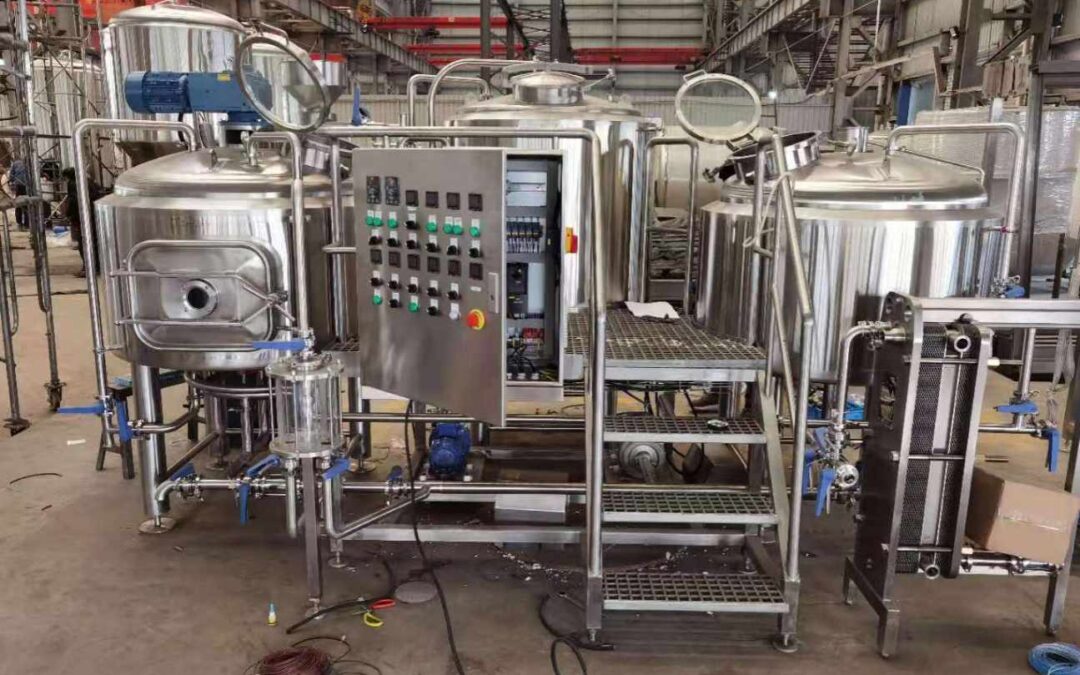Building a brewery requires careful planning, design, and execution. Here are some general steps to consider when building a brewery:
- Determine the type and size of your brewery: Will your brewery be a nano-brewery, a micro-brewery, or a large-scale production brewery? You need to determine the type of beer you want to brew and the target audience to decide on the size of your brewery.
- Find a suitable location: Look for a location that meets your brewery’s size, zoning, and environmental requirements. Choose a location with enough space for brewing, storage, and other brewery-related activities.
- Develop a business plan: Develop a comprehensive business plan that includes financial projections, market analysis, and marketing strategy. Your business plan should also include the cost of building the brewery and the equipment needed.
- Obtain necessary permits and licenses: Contact your local government agencies and obtain the necessary permits and licenses required to operate a brewery. This may include state and local permits, zoning approvals, and building permits.
- Design your brewery layout: Work with an architect and a brewery equipment supplier to design the layout of your brewery. Consider the flow of materials and personnel, the size of the brewing equipment, and the location of other necessary equipment.
- Purchase equipment: Purchase brewing equipment that meets the needs of your brewery. You will need kettles, fermenters, bottling or canning equipment, and refrigeration equipment. Consider the quality and durability of the equipment and the level of automation you want.
- Install utilities and plumbing: Install utilities such as electrical, gas, water, and waste disposal systems. You will also need to install plumbing for the brewing equipment, cooling systems, and other necessary systems.
- Hire and train staff: Hire a team that will help run your brewery, including brewmasters, sales staff, and administrative staff. Train your staff on brewery operations, customer service, and safety protocols.
- Start brewing: Once your brewery is built and equipped, it’s time to start brewing! Test and refine your beer recipes until you are happy with the taste and quality of your products.
Key Brewery Position Best Practices:
Use World Class 304 Stainless Steel Equipment:
World Class 304 stainless steel brewery equipment refers to brewery equipment made from high-quality 304 stainless steel, which is a common and popular grade of stainless steel used in the food and beverage industry.
304 stainless steel is known for its high resistance to corrosion, which is a critical feature for brewery equipment that comes into contact with liquids such as beer, which can be acidic and corrosive. This resistance to corrosion ensures that the brewery equipment is long-lasting, durable, and easy to clean, helping to maintain the quality and purity of the beer being produced.
World-class 304 stainless steel brewery equipment is typically made to exacting standards, with high-quality materials and precision engineering, to ensure that the brewing process is as efficient and effective as possible. This can include a range of equipment such as kettles, fermenters, brite tanks, and piping, all made from high-grade 304 stainless steel.
One of the key benefits of using world-class 304 stainless steel brewery equipment is that it helps to maintain the purity and flavor of the beer being produced. The high-quality stainless steel material does not react with the beer, which means that the beer is not contaminated or altered by the equipment during the brewing process.
Overall, world-class 304 stainless steel brewery equipment is an excellent choice for breweries that want to produce high-quality, pure, and consistent beer, and is a testament to the quality and craftsmanship of the brewery equipment industry.
Building a brewery can be a complex and challenging process, but with proper planning and execution, it can be a rewarding venture.
Use A High Quality Well Positioned Gravity Sink:
A brewery gravity sink, also known as a mash tun or lauter tun, is an important piece of equipment used in the brewing process. It is a vessel used for mixing and separating the grains and wort in the brewing process.
The gravity sink is typically made of stainless steel and has a false bottom that allows the liquid to drain through while holding back the grains. The false bottom has small holes in it to allow the liquid, or wort, to pass through but not the grains.
The brewing process begins by mixing the grains and water in the gravity sink to create a mash, which is then heated to convert the starches in the grains to sugars. The wort is then drained from the gravity sink through the false bottom and into a kettle for boiling and further processing.
After the wort has been drained from the gravity sink, the remaining grains are rinsed with hot water to extract as much sugar as possible. This process, known as lautering, is done by slowly pouring hot water over the grains, which helps to rinse out any remaining sugars and flavors.
The gravity sink is an essential piece of equipment in the brewing process, and its design and construction can have a significant impact on the quality of the beer produced. A well-designed gravity sink can help to extract the maximum amount of sugar and flavor from the grains while minimizing the amount of sediment and other impurities that make it into the final beer.
Use Assisted Grain-Out (doughing out) With Hydraulic Knives & Gearboxes
Doughing out is a term used in brewing that refers to the process of mixing the grains with hot water to create a mash. This process is the first step in the brewing process, and it is essential for converting the starches in the grains to sugars that can be fermented to produce alcohol.
During the doughing out process, the grains are added to hot water in a vessel called a mash tun, along with any specialty grains or adjuncts that are being used. The water is typically heated to a specific temperature, depending on the style of beer being brewed, and then the grains are added and mixed together thoroughly to create a thick, porridge-like mixture known as the mash.
The temperature of the water used in the doughing out process is critical, as it affects the enzymes in the grains that break down the starches into fermentable sugars. Different temperatures and durations of doughing out can affect the types and amounts of sugars that are produced, which can impact the flavor, body, and alcohol content of the final beer.
After the doughing out process is complete, the mash is typically allowed to rest for a period of time, during which the enzymes in the grains work to break down the starches into fermentable sugars. The resulting liquid, known as wort, is then drained from the mash tun and transferred to a boiling kettle, where it is boiled with hops and other ingredients to create the final flavor and aroma profile of the beer.
Overall, the doughing out process is an essential step in the brewing process, and the quality and consistency of this process can have a significant impact on the quality of the beer produced.
Use Rapid Rebatching (dough in) Via A Grist and Grist Hydrator:
Rebatching, also known as dough-in, is a process used in brewing that involves taking a portion of a previously made batch of beer, and using it as the starting point for a new batch. This process is also sometimes called “parti-gyle” brewing.
The rebatching process starts with the grains, which are mashed and sparged in the same way as a normal brewing process. However, instead of boiling the resulting wort and adding hops and other ingredients, the wort is combined with a portion of the previously made batch of beer, which serves as the source of the required sugars, flavor, and color.
The ratio of fresh wort to previously made beer can vary depending on the desired strength and character of the new beer. Typically, the rebatching process is used to produce a lower strength beer than the original batch, as most of the fermentable sugars have already been extracted from the grains in the first batch.
Rebatching can be a cost-effective way to produce a new batch of beer, as it allows brewers to reuse some of the ingredients and equipment from the previous batch. It can also be used to produce beers with unique flavor profiles, as the previously made beer can impart its own flavors and characteristics to the new batch.
However, the rebatching process can be challenging, as it requires precise control of the brewing process to achieve consistent results. The brewing equipment, such as the mash tun and boiling kettle, must be properly cleaned and sanitized before the rebatching process to prevent contamination from the previous batch.
Overall, rebatching, or dough-in, is a brewing process that can be used to produce unique and cost-effective beers, but it requires careful planning, attention to detail, and precise control of the brewing process to achieve consistent results.
Further to the above creating a well-positioned brewery involves several steps, including:
- Before starting your brewery, research the market to determine the demand for different types of beer and identify any gaps in the market that you can fill.
- Create a unique brand identity for your brewery that sets you apart from the competition. This includes developing a name, logo, and packaging that are memorable and recognizable.
- Choose a location for your brewery that is easily accessible to your target market, has good visibility, and is located in an area that is conducive to a brewery, such as an industrial or commercial district.
- Build a strong online presence for your brewery by creating a website, social media profiles, and other online marketing materials. Use these channels to engage with your customers, promote your products, and build a loyal following.
- Offer a unique customer experience that sets your brewery apart from others. This can include hosting events, offering brewery tours, and creating a welcoming and inviting atmosphere for your customers.
- Build relationships with local businesses, such as restaurants, bars, and liquor stores, to increase the visibility and availability of your products.
- Focus on producing high-quality beer that is consistent in taste and meets the expectations of your customers. This will help you build a positive reputation and a loyal customer base.
By following these steps, you can create a well-positioned brewery that is positioned for success in the competitive beer industry. Have any questions about setting up your brewery better for future success? We are always around to help!

